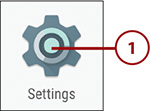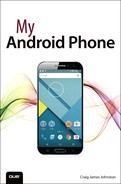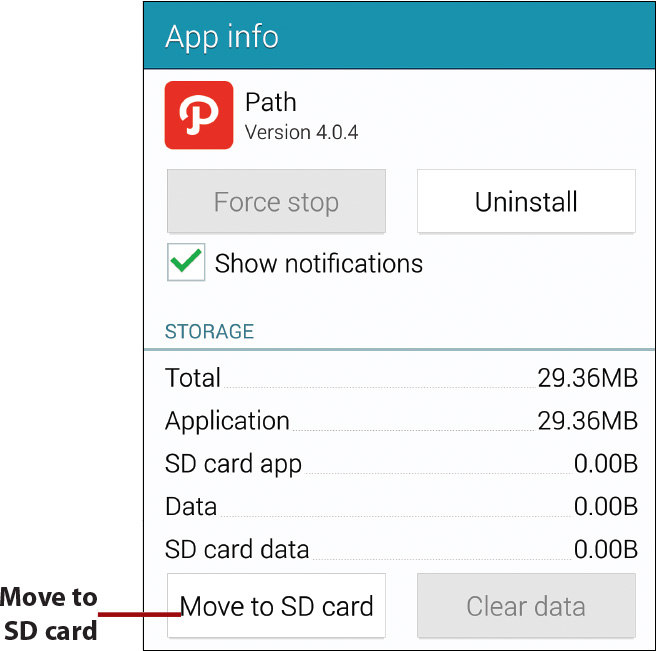13. Maintaining Your Android Phone and Solving Problems
In this chapter, you find out how to maintain your Android phone and solve problems. Topics include the following:
→ Identifying battery-hungry apps
→ Caring for your Android phone
Every so often, Google releases new versions of Android that have bug fixes and new features. In this chapter, you find out how to upgrade your Android phone to a new version of Android and how to tackle common problem-solving issues and general maintenance of your phone.
Updating Android
New releases of Android are always exciting because they add new features, fix bugs, and tweak the user interface. Here is how to update your Android phone.
Updates to Android are not delivered on a set schedule. The update messages appear as you turn on your Android phone, and they remain in the Notification panel until you install the update. If you tap Install Later, your Android phone reminds you every 30 minutes that there’s an update. Sometimes, people like to wait to see if there are any bugs that need to be worked out before they update, so when you choose to update is up to you.
1. Tap Download.

2. Tap Download to download the Android update to your phone.

3. Tap Restart and Install. Your Android phone reboots and applies the update, showing you the status of its progress. When the update is complete, you see the Lock screen and you can use your phone normally.

Manually Checking for Updates
If you think there should be an update for your Android phone, but you have not yet received the onscreen notification, you can check manually by tapping Settings, About Phone, and System Updates. If there are updates, they are listed on this screen. If not, tap Check For Update to check manually.
Optimizing Battery Life
The battery in your Android phone is a lithium-ion battery that provides good battery life when you take care of it. Changing the way you use your Android phone helps prolong the battery’s life, which gives you more hours in a day to use it.
Look After the Battery
There are specific actions you can take to correctly care for the battery in your Android phone. Caring for your battery helps it last longer.
• Try to avoid discharging the battery completely. Fully discharging the battery too frequently harms the battery. Instead, try to keep it partially charged at all times (except as described in the next step).
• To avoid a false battery-level indication on your Android phone, let the battery fully discharge about every 30 charges. Lithium-ion batteries do not have “memory” like older battery technologies; the battery meter gives a false reading if you don’t fully discharge the battery every 30 charges.
• Do not leave your Android phone in a hot car or out in the sun anywhere, including on the beach, because this can damage the battery and make it lose its charge quickly. Leaving your Android phone lying in the snow or in extreme cold also damages the battery.
• Consider having multiple chargers. For example, you could have one at home, one at work, and maybe one at a client’s site. This enables you to always keep your Android phone charged.
Determine What Is Using the Battery
Your Android phone enables you to see exactly what apps and system processes are using your battery. Having access to this information can help you alter your usage patterns and reduce the battery drain.
1. Tap Settings.

2. Tap Battery in the Device section.

3. Tap to manually refresh the display.
4. Tap an app or Android service to see more details about it, including how much time it has been active, how much processor (CPU) time it has used, and how much data it has sent and received (if applicable).
5. Tap the battery history graph for more details on the battery history and how it relates to GPS, Wi-Fi, cellular data, and screen-on time.

6. Cellular Network Signal indicates when the cellular radio was being used and the signal strength through the graph’s time span.
7. Wi-Fi indicates when the Wi-Fi radio was used through the battery graph’s time span.
8. Awake indicates when your Android phone was awake through the time span.
9. Screen On indicates when your phone’s screen was on through the battery graph’s time span.
10. Charging indicates when your phone was charging through the battery graph’s time span.

What Is Battery Saver?
When Battery Saver is enabled, your phone severely limits its functionality in order to keep the battery alive as long as possible. Your phone reduces its performance, turns off Ambient Display, stops synchronizing data in the background, and stops vibrating for notifications. All these steps help increase the battery discharge rate, but of course your phone’s usefulness is much more limited than normal. You can either manually activate Battery Saver or set your phone to automatically activate it when the remaining battery charge reaches 5% or 15%. From the Battery screen, tap the Menu icon. Tap the On/Off switch to manually activate Battery Saver. To leave Battery Saver off, but set it to automatically activate when the remaining charge reaches a certain level, tap on Turn On Automatically, and choose either 5% or 15%.
Controlling Apps and Memory
Android phone apps run in a specific memory space that is limited to between 1-3 GB. (This number varies by phone manufacturer.) Although Android tries to do a good job of managing this memory, sometimes you have to close an app that is consuming too much memory.

2. Tap Apps in the Device section.

3. Tap Running to see only apps that are currently running.
4. The graph shows you how much memory is being used by the system (Android), apps that are currently running, and how much free memory there is available.
5. Tap an app to see more information about it.

6. Tap Stop if you believe the app is misbehaving.
7. Tap to report an app to Google. You might want to do this if it is misbehaving, using up too many resources, or you suspect it is stealing data.

When Should I Manually Stop an App?
After you have been using your Android phone for a while, you’ll become familiar with how long it takes to do certain tasks, such as typing, navigating menus, and so on. If you notice your phone becoming slow or not behaving the way you think it should, the culprit could be a new app you recently installed. Because Android never quits apps on its own, that new app continues running in the background and may be causing your phone to slow down. This is when it is useful to manually stop an app.
Checking and Controlling Data Usage
You might want to see how each app consumes data while it runs in the foreground or in the background. You might also want to limit an app’s data consumption when it runs in the background. Finally, you can set your cellular billing cycle and a data limit to let your phone warn when you are getting close to your limit.

2. Tap Data Usage.

Showing Cellular and Wi-Fi Usage
Because Wi-Fi is free and doesn’t count toward your cellular data plan, many people are only interested in seeing their data usage, what apps are using how much cellular data, and setting cellular data limits. However, you can also show your phone’s Wi-Fi usage by tapping the Menu icon and choosing Show Wi-Fi. You then see two tabs: one for cellular and one for Wi-Fi.

Set a Data Usage Warning
You might want to let your phone warn you when you reach a certain amount of cellular data usage each month.
1. Tap the date range.
2. Tap Change Cycle.

3. Choose the first day of your cellular billing cycle.
4. Tap Set.

5. Drag the data warning bar left and right to choose at what point of cellular data usage you want to be warned.

Set a Data Usage Limit
You might want to let your phone limit your data usage after it reaches your cellular data plan limit. If you use this feature, when your cellular data usage reaches the limit you set, your phone stops using cellular data; however, it continues to use Wi-Fi data.
1. Tap the date range.
2. Tap Change Cycle.

3. Choose the first day of your cellular billing cycle.
4. Tap Set.

5. Tap the On/Off switch next to Set Cellular Data Limit to enable setting a cellular data limit.
6. Drag the data limit bar left and right to choose the maximum amount of cellular data you want your phone to use before it stops using cellular data altogether.

Caring for the Android Phone’s Exterior
Because you need to touch your Android phone’s screen to use it, it picks up oils and other residue from your hands. You also might get dirt on other parts of the phone. Here is how to clean your Android phone.
1. Wipe the screen with a microfiber cloth. You can purchase these in most electronics stores, or you can use the one that came with your sunglasses.
2. To clean dirt off other parts of your phone, wipe it with a damp cloth. Never use soap or chemicals on your Android phone because they can damage it.
3. When inserting the Micro-USB connector, try not to force it in the wrong way. If you damage the pins inside your Android phone, you cannot charge it.
Getting Help with Your Android Phone
Many resources are on the Internet where you can get help with your Android phone.
1. Visit the Official Google website at http://www.android.com.
2. Check out some Android blogs:
• Android Central at http://www.androidcentral.com/
• Android Guys at http://www.androidguys.com/
• Androinica at http://androinica.com/
3. Contact me. I don’t mind answering your questions, so visit my official My Android Phone book site at http://www.CraigsBooks.info.


